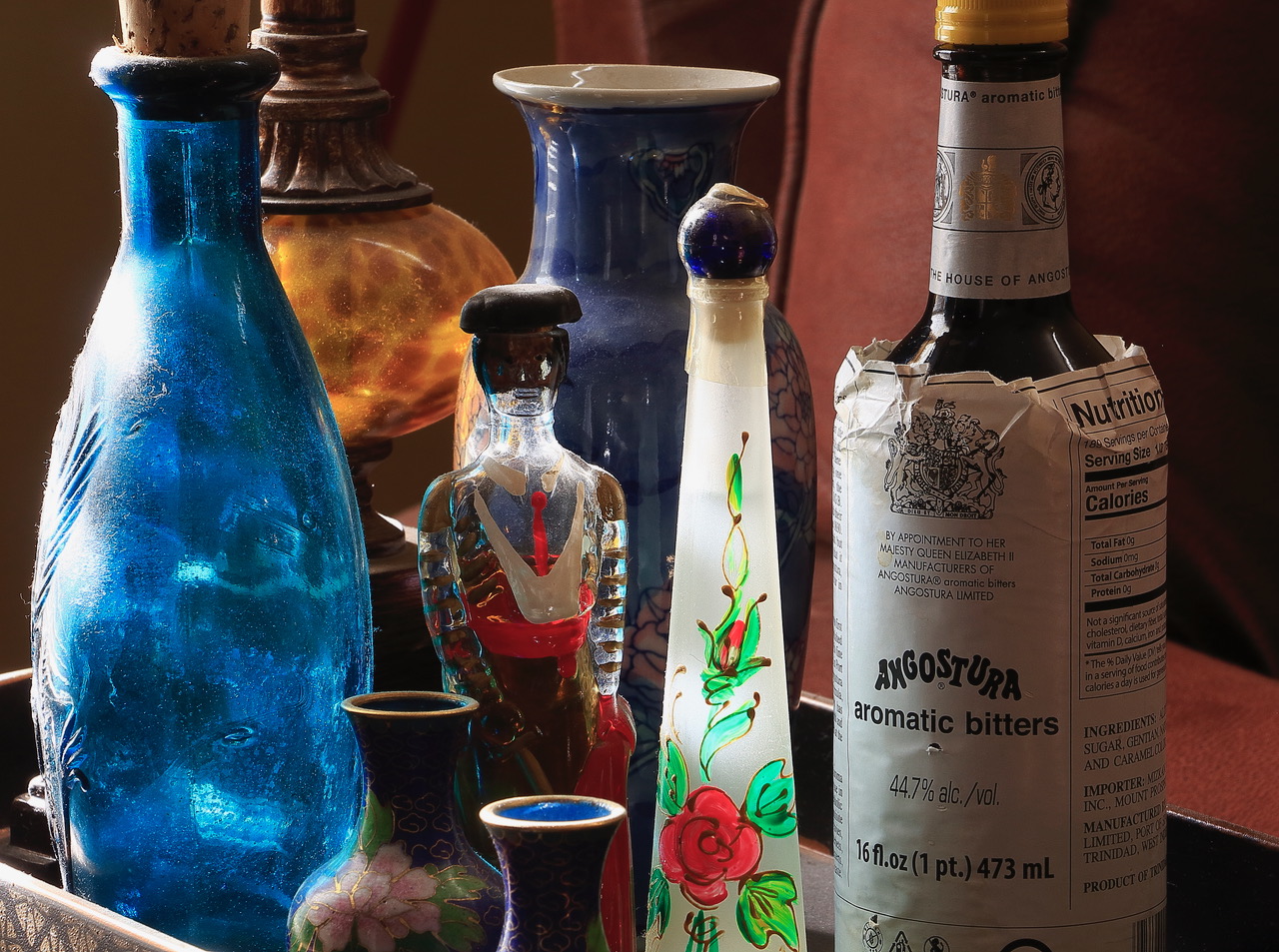Bitters, A History In Life And Literature
February 2, 2022By Tom Poland
Among the dusty bottles and vase stand three alcoholic potions. I bought the matador-like bottle in Madrid when I traveled by train through hard, brown Spain. Next to it stands an elegant bottle from Italy that contains a liqueur, flavor and strength unknown. A rose and word, “Roma,” are all that’s on the bottle. To its right Angostura Bitters dominates the photograph.
The seals remain intact. Dust proves these potions have yet to be tasted. Of the three, Angostura Bitters is the one I’ve most seen in literature. It dominates there as well. It’s referred to as a botanical and contains herbs, spices and extracts of grasses, roots, leaves and fruits dissolved in alcohol. It’s promoted as “ideal for balancing alcoholic drinks, cleansing the palate and facilitating digestion.”
In 1824, Dr. Johann Siegert, surgeon general for Venezuelan military leader Simón Bolívar, created Bitters from a blend of herbs and spices to cure upset stomachs. Originally called Dr. Siegert’s Aromatic Bitters, it stops heartburn in its tracks, for me at least, but that’s not why I like it. I like it because of its place in literature.
 It’s no secret that Hemingway enjoyed a drink or two, and among his favorite additives was Bitters. He liked Angostura Bitters in his gin and tonic, a fine summer drink. Among his favorite drinks when voyaging on his boat, Pilar, was Vermouth Panache, a blend of sweet and dry vermouth with Angostura Bitters. I’ve never tried it and doubt I will but some people will drive you to drink most anything. Hemingway supposedly said, “I drink to make other people more interesting.” Amen to that in this era of clones and drones glued to phones. There’s no conversing with them.
It’s no secret that Hemingway enjoyed a drink or two, and among his favorite additives was Bitters. He liked Angostura Bitters in his gin and tonic, a fine summer drink. Among his favorite drinks when voyaging on his boat, Pilar, was Vermouth Panache, a blend of sweet and dry vermouth with Angostura Bitters. I’ve never tried it and doubt I will but some people will drive you to drink most anything. Hemingway supposedly said, “I drink to make other people more interesting.” Amen to that in this era of clones and drones glued to phones. There’s no conversing with them.
Hemingway concocted a drink he called “Death in the Stream.” He described it as “reviving and refreshing.” Amen to that as well. The drink appears in his posthumous Islands in the Stream while the main character, Thomas Hudson, is out deep-sea fishing. Excerpt—“Where Thomas Hudson lay on the mattress his head was in the shade cast by the platform at the forward end of the flying bridge where the controls were and when Eddy came aft with the tall cold drink made of gin, lime juice, green coconut water, and chipped ice with just enough Angostura bitters to give it a rusty, rose color, he held the drink in the shadow so the ice would not melt while he looked out over the sea.”
You feel like you’re there in the Gulf Stream, don’t you.
Angostura Bitters. Red like varnish, In Islands in the Stream, Hemingway also wrote, “Hudson feels the sharpness of the lime, the aromatic varnishy taste of the Angostura and the gin stiffening the lightness of the ice-cold coconut water.” I read that a bar in Seattle used 45 cases of it to varnish their wood.
It’s essential to the Old Fashioned cocktail. The recipe for Angostura Bitters is a closely guarded secret. Its bright yellow cap is a trademark, but what sets apart a bottle of Angostura bitters is the over-sized label. Legend holds that when Siegert’s sons took over the business, they entered the old man’s Bitters in a competition to gain exposure. In the rush to ready Bitters for judging, one brother procured the bottles, while another had labels printed. Somewhere along the line they had a Cool Hand Luke “failure to communicate.” The labels were too big. I suppose you could say the bottles were too small. With time short, they had no choice but to stick the big labels onto small bottles. Angostura Bitters lost the competition, but a judge thought the labels set the product apart from others. Time validates his opinion.
Angostura Bitters, offered by the House of Angostura in Trinidad and Tobago and an indelible part of Hemingway lore.
Visit Tom’s website at www.tompoland.net
Email Tom at [email protected]



















